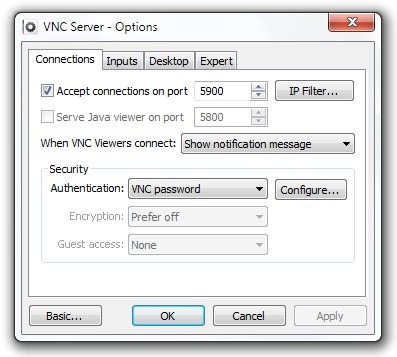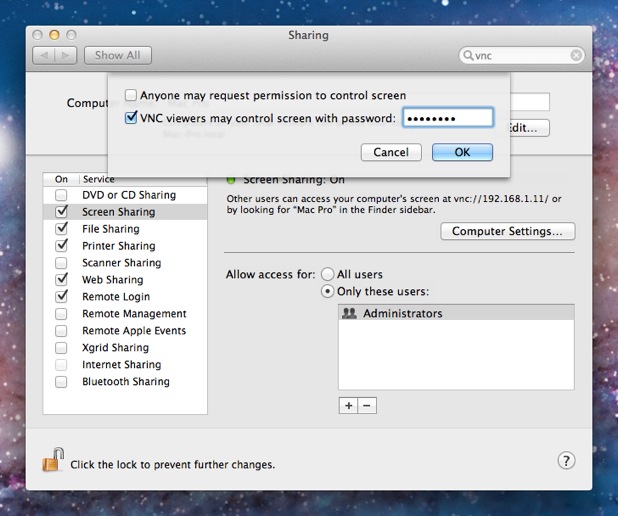
- #VNC FOR MAC MAC OS X#
- #VNC FOR MAC MAC OS#
- #VNC FOR MAC SOFTWARE#
- #VNC FOR MAC PASSWORD#
- #VNC FOR MAC PC#
There appears to be something about the virtual interface that's created that works whereas using the default en0 (wired) or en1 (wireless) interfaces are problematic. That caused us to try having the system connect to our VPN while on the local campus and sure enough it worked as well. The same laptop on the local network would get absolutely unworkable performance on the local wired or wireless network, but would work just fine over our Cisco VPN (but using the builtin VPN options for the Mac, not the Cisco VPN client) from outside our campus. In testing to make sure our network wasn't part of the problem, we tried to VNC to a system over our VPN from outside our office. These same issues do not exist with Leopard or Snow Leopard. See, for example, this Apple Discussion thread. Unfortunately this is not currently supported.Here's a workaround for some VNC issues that may appear with Lion.Ī quick search will show a growing list of users having issues with VNC in Lion.
#VNC FOR MAC MAC OS#
Remote access from a Windows computer to your mac OS work computer Click OK to all the other prompts and you will be connected to your Windows work desktop. As the remote desktop connects you will be prompted for your staff username (use the format registry\ abcde34p) and password. Remotely connecting to the University networkĬonnect with An圜onnect VPN, then click on your work computer's remote connection set up in Microsoft Remote Desktop 10.


You have now finished setting up your remote connection.
#VNC FOR MAC PC#
In PC name add the fully qualified domain name of your Windows work computer.In Connection name, give your work computer a name you will recognise.Open the app and click on the plus sign in the menu bar to add the new remote desktop.Go to the Apple App Store and download the Microsoft Remote Desktop 10 application.You can now click the Disconnect button.
#VNC FOR MAC PASSWORD#
You will now be prompted to enter your password again, click OK and Accept for the policy again.In the connection box use the drop-down menu to choose UO- VPN-STAFF.Enter your University staff username and password at the prompt and click Accept when prompted about the University's VPN Access policies.Open An圜onnect, type .nz into the connection box and click the Connect button.

Log in with your University staff username and password, then download the Cisco An圜onnect VPN client and follow the installation instructions.On your remote mac OS computer, go to .nz/.Windows Remote Desktop setup Installing and configuring the Cisco An圜onnect VPN Client Use the instructions for your work computer's Windows version in the article below: You will need to be logged in as an administrator to change these settings, or ask your IT support staff to do it for you. Installing and connecting to An圜onnect VPN Remote access from a mac OS computer to your Windows work computerįirstly set up your work Windows computer to enable remote connections. There is usually no need for any complex configuration, but both your remote and work computers should have a reasonable level of security. Set up Screen Sharing and test that you have set everything up correctly well in advance of when you need to use it. or, with an SSH tunnel: vnc://localhost:5900.vnc:// your fully qualified domain name.

Use Screen Sharing to connect to your work computer by clicking on the "Go" menu in the Finder and selecting "Connect to Server" and enter the following address: ssh -C -N -L 5901:localhost:5900 your your fully qualified domain name.If you are using an SSH Tunnel, open the Terminal app on your remote Mac and connect the tunnel to your work computer:.
#VNC FOR MAC SOFTWARE#
#VNC FOR MAC MAC OS X#
You can remotely access your mac OS X work computer as follows: ITS suggests that you use the following secure channels if you plan to use Screen Sharing or other VNC clients: Mac OS Screen Sharing or other VNC clients (programs that allow you to access your desktop remotely) can be used, but most do not encrypt their communications. Remote access from a mac OS computer to your mac OS work computer You should note this somewhere you can access it from home. See the related answer for instructions on finding your fully qualified domain name. Before accessing your work computer remotely, you will need to know your work computer's fully qualified domain name.


 0 kommentar(er)
0 kommentar(er)
